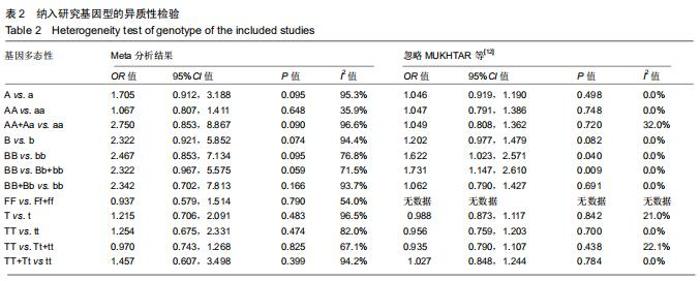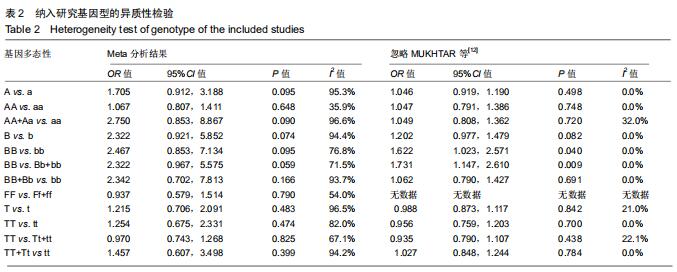Chinese Journal of Tissue Engineering Research ›› 2020, Vol. 24 ›› Issue (33): 5405-5412.doi: 10.3969/j.issn.2095-4344.2833
Associations between vitamin D receptor gene polymorphisms and osteoarthritis: a meta-analysis
Feng Chengqin1, Zeng Ping2, Luo Jun1, Liu Jinfu1, Huang Jiaxing1
1Graduate School of Guangxi University of Chinese Medicine, Nanning 530299, Guangxi Zhuang Autonomous Region, China; 2Second Department of Orthopedics, First Affiliated Hospital of Guangxi University of Chinese Medicine, Nanning 530023, Guangxi Zhuang Autonomous Region, China
-
Received:2019-11-20Revised:2019-11-29Accepted:2020-01-17Online:2020-11-28Published:2020-10-15 -
Contact:Zeng Ping, MD, Chief physician, Doctoral supervisor, Second Department of Orthopedics, First Affiliated Hospital of Guangxi University of Chinese Medicine, Nanning 530023, Guangxi Zhuang Autonomous Region, China -
About author:Feng Chengqin, Master candidate, Physician, Graduate School of Guangxi University of Chinese Medicine, Nanning 530299, Guangxi Zhuang Autonomous Region, China -
Supported by:the National Scientific Research Project of Traditional Chinese Medicine Industry, No. 201507001; the Science and Technology Project of National Administration of Traditional Chinese Medicine, No. GZMZ1206
CLC Number:
Cite this article
Feng Chengqin, Zeng Ping, Luo Jun, Liu Jinfu, Huang Jiaxing. Associations between vitamin D receptor gene polymorphisms and osteoarthritis: a meta-analysis[J]. Chinese Journal of Tissue Engineering Research, 2020, 24(33): 5405-5412.
share this article
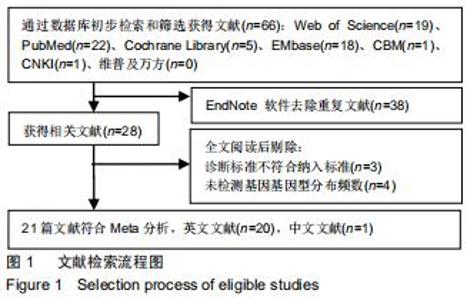
2.1 文献检索结果 按检索策略检索数据库,通过阅读题目和摘要初步筛选可能符合的文献,在Web of Science数据库检索到19篇,PubMed数据库检索到22篇,Cochrane Library检索到5篇,EMbase检索到18篇,CNKI检索到1篇,中国生物医学文献数据库检索到1篇,通过Endnote软件去除重复文献38篇,阅读全文后剔除7篇诊断标准不符合纳入标准的文献,最后21篇文献符合Meta分析[12-13,15-33],包括20篇英文文献和1篇中文文献。流程图详见图1。21篇文献中共7 109例患者,其中包括病例组3 123例骨关节炎患者、对照组非骨关节炎患者4 006例。 "
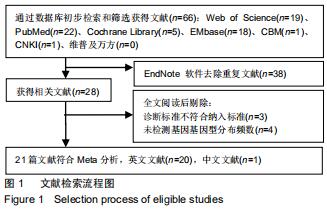
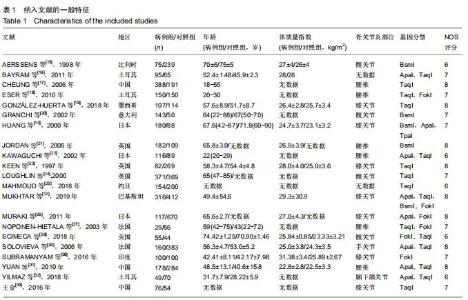
在纳入的研究中,8篇文献对病例组1 211例和对照组 2 061例进行了ApaI多态性与骨关节炎的相关性研究,5篇文献对病例组896例和对照组789例进行了BsmI多态性与骨关节炎的相关性研究,6篇文献对病例组767例和对照组1 432例进行了FokI多态性与骨关节炎相关性研究,16篇文献对病例组2 506例和对照组2 749例进行了TaqI多态性与骨关节炎相关性研究。HUANG等[13]的研究结果虽然提供了手部、髋部和膝关节骨关节炎3组比较的数据,但多部位骨关节炎患者纳入了不止一组比较。在对照组中也有类似的情况,其中一些被包括在多次比较中,所以为了避免重复,病例组只纳入膝关节组,对照组为无骨关节炎组。各纳入研究的基本资料见表1。所有纳入的研究都是高质量的,NOS评分为≥6分,见图2。 "
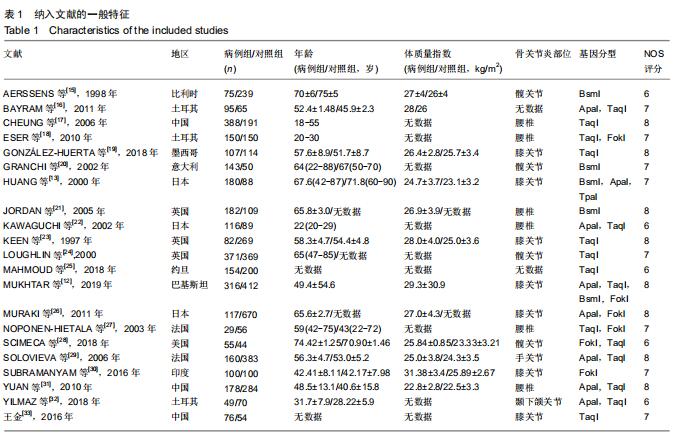
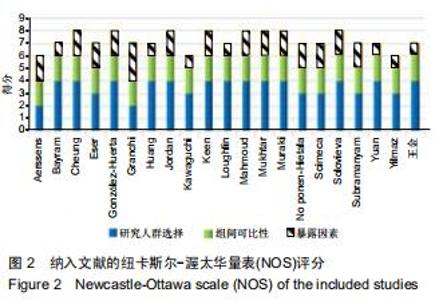
在纳入的研究中,8篇文献对病例组1 211例和对照组 2 061例进行了ApaI多态性与骨关节炎的相关性研究,5篇文献对病例组896例和对照组789例进行了BsmI多态性与骨关节炎的相关性研究,6篇文献对病例组767例和对照组1 432例进行了FokI多态性与骨关节炎相关性研究,16篇文献对病例组2 506例和对照组2 749例进行了TaqI多态性与骨关节炎相关性研究。HUANG等[13]的研究结果虽然提供了手部、髋部和膝关节骨关节炎3组比较的数据,但多部位骨关节炎患者纳入了不止一组比较。在对照组中也有类似的情况,其中一些被包括在多次比较中,所以为了避免重复,病例组只纳入膝关节组,对照组为无骨关节炎组。各纳入研究的基本资料见表1。所有纳入的研究都是高质量的,NOS评分为≥6分,见图2。 "
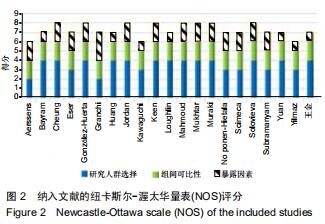
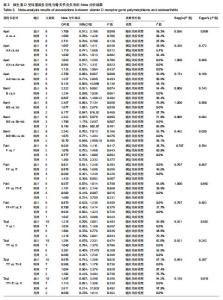
结果显示当忽略MUKHTAR等[12]的研究结果时,I2值由>50%变为<50%,所以异质性的来源是MUKHTAR等[12]的研究。维生素D受体FokI(FF vs Ff+ff)的研究行敏感性分析未找出明显异质性来源。通过仔细阅读MUKHTAR等[12]的研究,发现病例组及对照组的纳入符合纳入标准,维生素D受体基因也是通过PCR技术测定,实验方法未发现明显异常,基因型数据分布符合哈代温伯格平衡定律。但此次研究是唯一一篇对巴基斯坦人的研究,文章中也提到在巴基斯坦,70%的婚姻是近亲结婚,这是遗传疾病遗传给下一代的主要原因,所以这可能是异质性存在的来源。发表偏倚检测对所有基因型进行Egger’s检验和Begg’s检验,未发现明显的发表偏倚,说明结果稳定性较高,各基因型多态性纳入研究的发表偏倚检测的P 值详见表3。 "
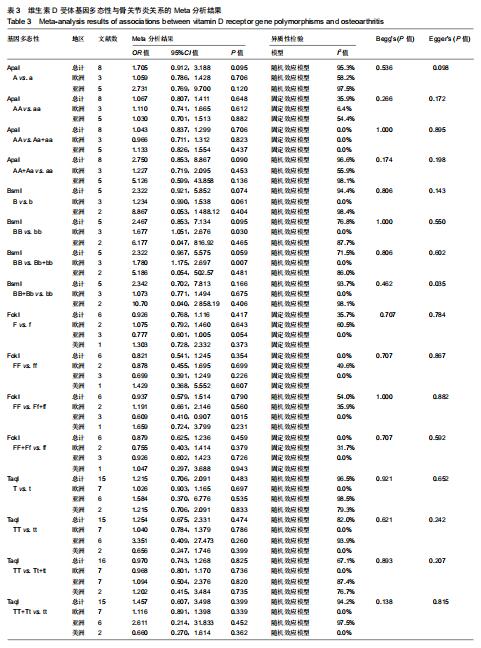
|
[1] KRAUS VB, BLANCO FJ, ENGLUND M, et al. Call for standardized definitions of osteoarthritis and risk stratification for clinical trials and clinical use.Osteoarthritis Cartilage. 2015;23(8): 1233-1241.
[2] CROSS M, SMITH E, HOY D, et al. The global burden of hip and knee osteoarthritis: estimates from the global burden of disease 2010 study. Ann Rheum Dis.2014;73(7):1323-1330.
[3] BORTOLUZZI A, FURINI F. Osteoarthritis and its management Epidemiology, nutritional aspects and environmental factors. Autoimmun Rev.2018;17(11):1097-1104.
[4] O'NEILL TW, MCCABE PS. Update on the epidemiology, risk factors and disease outcomes of osteoarthritis.Clin Rheumatol. 2018;32(2):312-326.
[5] GENG R, XU Y, HU W. The association between MMP-1 gene rs1799750 polymorphism and knee osteoarthritis risk.Biosci Rep. 2018;38(5).pii: BSR20181257.
[6] BAI Y, GAO S, LIU Y, et al. Correlation between Interleukin-17 gene polymorphism and osteoarthritis susceptibility in Han Chinese population. BMC Med Genet.2019;20(1):20.
[7] COLOMBINI A, CAUCI S, LOMBARDI G, et al. Relationship between vitamin D receptor gene (VDR) polymorphisms, vitamin D status, osteoarthritis and intervertebral disc degeneration. J Steroid Biochem Mol Biol.2013;138():24-40.
[8] WANG Y, WACTAWSKI-WENDE J, SUCHESTON-CAMPBELL LE, et al. The influence of genetic susceptibility and calcium plus vitamin D supplementation on fracture riskAm J Clin Nutr. 2017; 105(4):970-979.
[9] IOM. Dietary Refence Intakes for Calcium and Vitamin D.The National Academies Press:Washington,DC,USA.2011.
[10] CHRISTAKOS S, DHAWAN P, VERSTUYF A, et al. Vitamin D: Metabolism, Molecular Mechanism of Action, and Pleiotropic Effects. Physiol Rev.2016;96(1):365-408.
[11] Colombini A, Cauci S, Lombardi G, et al. Relationship between vitamin D receptor gene (VDR) polymorphisms, vitamin D status, osteoarthritis and intervertebral disc degeneration.J Steroid Biochem Mol Biol. 2013; 138:24-40.
[12] MUKHTAR M, SHEIKH N, SUQAINA SK, et al. Vitamin D Receptor Gene Polymorphism: An Important Predictor of Arthritis Development. BioMed Res Int.2019;2019:8326246.
[13] HUANG J, USHIYAMA T, INOUE K, et al. Vitamin D receptor gene polymorphisms and osteoarthritis of the hand,hip,and knee: acase-control study in Japan.Rheumatology(Oxford, England). 2000; 39(1):79-84.
[14] 曾宪涛,刘慧,陈曦,等.Meta分析系列之四:观察性研究的质量评价工具[J].中国循证心血管医学杂志,2012,4(4):297-299.
[15] AERSSENS J, DEQUEKER J, PEETERS J, et al. Lack of association between osteoarthritis of the hip and gene polymorphisms of VDR, COL1A1, and COL2A1 in postmenopausal women. Arthritis Rheum. 1998;41(11):1946-1950.
[16] BAYRAM B, SAYIN BE, TÜRKOĞLU Z, et al. An Investigation Into the Relationship Between Taq1 and Apa1 Polymorphisms of the Vitamin D Receptor Gene and the Development of Osteoarthritis.Turk J Rheumatol. 2011;26(4):303-307.
[17] CHEUNG KM, CHAN D, KARPPINEN J, et al. Association of the Taq I allele in vitamin D receptor with degenerative disc disease and disc bulge in a Chinese population.Spine (Phila Pa 1976). 2006;31(10): 1143-1148.
[18] ESER B, CORA T, ESER O, et al. Association of the polymorphisms of vitamin D receptor and aggrecan genes with degenerative disc disease. Genet Test Mol Biomarkers.2010; 14(3):313-317.
[19] GONZÁLEZ-HUERTA NC, BORGONIO-CUADRA VM, MORALES-HERNÁNDEZ E, et al. Vitamin D receptor gene polymorphisms and susceptibility for primary osteoarthritis of the knee in a Latin American population.Null.2018;58(1):6.
[20] GRANCHI D, STEA S, SUDANESE A, et al. Association of two gene polymorphisms with osteoarthritis secondary to hip dysplasia.Clin Orthop Relat Res.2002;(403):108-117.
[21] JORDAN KM, SYDDALL H, DENNISON EM, et al. Birthweight, vitamin D receptor gene polymorphism, and risk of lumbar spine osteoarthritis. J Rheumatol.2005;32(4):678-683.
[22] KAWAGUCHI Y, KANAMORI M, ISHIHARA H, et al. The association of lumbar disc disease with vitamin-D receptor gene polymorphism. J Bone Joint Surg Am.2002;84-A(11):2022-2028.
[23] KEEN RW, HART DJ, LANCHBURY JS. Association of early osteoarthritis of the knee with a Taq I polymorphism of the vitamin D receptor gene.Arthritis Rheum.1997;40(8):1444-1449.
[24] LOUGHLIN J, SINSHEIMER JS, MUSTAFA Z, et al. Association analysis of the vitamin D receptor gene, the type I collagen gene COL1A1, and the estrogen receptor gene in idiopathic osteoarthritis.J Rheumatol.2000;27(3):779-784.
[25] MAHMOUD SAAH, ATOUM MF, AL-HOURANI HM, et al. Vitamin D deficiency and rs731236(taq1) vitamin D receptor gene polymorphism as possible risk factors for rheumatoid arthritis and osteoarthritis.Acta Medica Mediterranea.2018;34:209.
[26] MURAKI S, DENNISON E, JAMESON K, et al. Association of vitamin D status with knee pain and radiographic knee osteoarthritis. Osteoarthritis Cartilage.2011;19(11):1301-1306.
[27] NOPONEN-HIETALA N, KYLLÖNEN E, MÄNNIKKÖ M, et al. Sequence variations in the collagen IX and XI genes are associated with degenerative lumbar spinal stenosis.Ann Rheum Dis. 2003; 62(12):1208-1214.
[28] SCIMECA M, CENTOFANTI F, CELI M, et al. Vitamin D Receptor in Muscle Atrophy of Elderly Patients: A Key Element of Osteoporosis-Sarcopenia Connection.Aging Dis.2018;9(6): 952-964. [29] SOLOVIEVA S, HIRVONEN A, SIIVOLA P, et al. Vitamin D receptor gene polymorphisms and susceptibility of hand osteoarthritis in Finnish women.Arthritis Res Ther.2006;8(1):R20.
[30] SUBRAMANYAM K, POORNIMA S, JUTURU KK, et al. Missense FokI variant in the vitamin D receptor gene in primary knee osteoarthritis patients in south Indian population.Gene Rep.2016; 4:118-122.
[31] YUAN HY, TANG Y, LIANG YX, et al. Matrix metalloproteinase-3 and vitamin d receptor genetic polymorphisms, and their interactions with occupational exposure in lumbar disc degeneration. J Occup Health. 2010;52(1):23-30.
[32] YILMAZ AD, YAZICIOGLU D, TÜZÜNER ÖNCÜL AM, et al. Vitamin D receptor gene polymorphisms (Apa1 and Taq1) in temporomandibular joint internal derangement/osteoarthritis in a group of Turkish patients. Mol BiolRep.2018;45(6):1839-1848.
[33] 王金.阳虚质膝骨性关节炎忠者COL2A和VDR基因多态性研究[D].兰州:甘肃中医药大学,2016.
[34] HUNG M, BOUNSANGA J, VOSS MW, et al. Dietary and Supplemental Vitamin C and D on Symptom Severity and Physical Function in Knee Osteoarthritis.J Nutr Gerontol Geriatr. 2017;36(2-3): 121-133.
[35] MANOY P, YUKTANANDANA P, TANAVALEE A, et al. Vitamin D Supplementation Improves Quality of Life and Physical Performance in Osteoarthritis Patients.Nutrients.2017;9(8).pii: E799.
[36] HAUSSLER MR, WHITFIELD GK, HAUSSLER CA, et al. The nuclear vitamin D receptor: biological and molecular regulatory properties revealed.J Bone Miner Res.1998;13(3):325-349.
[37] SANGHI D, SRIVASTAVA RN, RAJ S, et al. Vitamin D receptor gene polymorphisms modulate the clinicoradiological response to vitamin D supplementation in knee osteoarthritis.Osteoarthritis Cartilage. 2014; 22:S235-S236.
[38] LI J, JIN D, FU S, et al. Insulin-like growth factor binding protein-3 modulates osteoblast differentiation via interaction with vitamin D receptor.Biochem Biophys Res Commun.2013;436(4):632-637.
[39] STARCZAK Y, REINKE DC, BARRATT KR, et al. Absence of vitamin D receptor in mature osteoclasts results in altered osteoclastic activity and bone loss.J Steroid Biochem Mol Biol. 2018;177:77-82.
[40] MOSAAD YM, HAMMAD EM, FAWZY Z, et al. Vitamin D receptor gene polymorphism as possible risk factor in rheumatoid arthritis and rheumatoid related osteoporosis.Human Immunol. 2014; 75(5):452-461.
[41] ZHANG L, YIN X, WANG J, et al. Associations between VDR Gene Polymorphisms and Osteoporosis Risk and Bone Mineral Density in Postmenopausal Women: A systematic review and Meta-Analysis.Sci Rep.2018;8(1):981.
[42] TETLOW LC, WOOLLEY DE. Expression of vitamin D receptors and matrix metalloproteinases in osteoarthritic cartilage and human articular chondrocytes in vitro.Osteoarthritis Cartilage. 2001;9:423-431.
[43] BAHAT G, SAKA B, ERTEN N, et al. BsmI polymorphism in the vitamin D receptor gene is associated with leg extensor muscle strength in elderly men.Aging Clin Exp Res.2010;22(3):198-205.
[44] UITTERLINDEN AG, BURGER H, VAN DUIJN CM, et al. Adjacent genes, for COL2A1 and the vitamin D receptor, are associated with separate features of radiographic osteoarthritis of the knee. Arthritis Rheum.2000;43(7):1456-1464.
[45] LIU H, HE H, LI S, et al. Vitamin D receptor gene polymorphisms and risk of osteoarthritis: a meta-analysis.Exp Biol Med(Maywood). 2014; 239(5):559-567. [46] ZHU ZH, JIN XZ, ZHANG W, et al. Associations between vitamin D receptor gene polymorphisms and osteoarthritis: an updated meta-analysis.Rheumatology (Oxford,England). 2014;53(6): 998-1008. |
| [1] | Min Youjiang, Yao Haihua, Sun Jie, Zhou Xuan, Yu Hang, Sun Qianpu, Hong Ensi. Effect of “three-tong acupuncture” on brain function of patients with spinal cord injury based on magnetic resonance technology [J]. Chinese Journal of Tissue Engineering Research, 2021, 25(在线): 1-8. |
| [2] | Peng Zhihao, Feng Zongquan, Zou Yonggen, Niu Guoqing, Wu Feng. Relationship of lower limb force line and the progression of lateral compartment arthritis after unicompartmental knee arthroplasty with mobile bearing [J]. Chinese Journal of Tissue Engineering Research, 2021, 25(9): 1368-1374. |
| [3] | Zhang Chong, Liu Zhiang, Yao Shuaihui, Gao Junsheng, Jiang Yan, Zhang Lu. Safety and effectiveness of topical application of tranexamic acid to reduce drainage of elderly femoral neck fractures after total hip arthroplasty [J]. Chinese Journal of Tissue Engineering Research, 2021, 25(9): 1381-1386. |
| [4] | Chen Junming, Yue Chen, He Peilin, Zhang Juntao, Sun Moyuan, Liu Youwen. Hip arthroplasty versus proximal femoral nail antirotation for intertrochanteric fractures in older adults: a meta-analysis [J]. Chinese Journal of Tissue Engineering Research, 2021, 25(9): 1452-1457. |
| [5] | Chen Jinping, Li Kui, Chen Qian, Guo Haoran, Zhang Yingbo, Wei Peng. Meta-analysis of the efficacy and safety of tranexamic acid in open spinal surgery [J]. Chinese Journal of Tissue Engineering Research, 2021, 25(9): 1458-1464. |
| [6] | Hu Kai, Qiao Xiaohong, Zhang Yonghong, Wang Dong, Qin Sihe. Treatment of displaced intra-articular calcaneal fractures with cannulated screws and plates: a meta-analysis of 15 randomized controlled trials [J]. Chinese Journal of Tissue Engineering Research, 2021, 25(9): 1465-1470. |
| [7] | Huang Dengcheng, Wang Zhike, Cao Xuewei. Comparison of the short-term efficacy of extracorporeal shock wave therapy for middle-aged and elderly knee osteoarthritis: a meta-analysis [J]. Chinese Journal of Tissue Engineering Research, 2021, 25(9): 1471-1476. |
| [8] | Ji Zhixiang, Lan Changgong. Polymorphism of urate transporter in gout and its correlation with gout treatment [J]. Chinese Journal of Tissue Engineering Research, 2021, 25(8): 1290-1298. |
| [9] | Wang Yongsheng, Wu Yang, Li Yanchun. Effect of acute high-intensity exercise on appetite hormones in adults: a meta-analysis [J]. Chinese Journal of Tissue Engineering Research, 2021, 25(8): 1305-1312. |
| [10] | Liu Xiangxiang, Huang Yunmei, Chen Wenlie, Lin Ruhui, Lu Xiaodong, Li Zuanfang, Xu Yaye, Huang Meiya, Li Xihai. Ultrastructural changes of the white zone cells of the meniscus in a rat model of early osteoarthritis [J]. Chinese Journal of Tissue Engineering Research, 2021, 25(8): 1237-1242. |
| [11] | Kong Desheng, He Jingjing, Feng Baofeng, Guo Ruiyun, Asiamah Ernest Amponsah, Lü Fei, Zhang Shuhan, Zhang Xiaolin, Ma Jun, Cui Huixian. Efficacy of mesenchymal stem cells in the spinal cord injury of large animal models: a meta-analysis [J]. Chinese Journal of Tissue Engineering Research, 2021, 25(7): 1142-1148. |
| [12] | Kong Lingbao, Lü Xin. Effect of implant selection and approach on support in the operation of posterolateral tibial plateau fractures [J]. Chinese Journal of Tissue Engineering Research, 2021, 25(6): 942-947. |
| [13] | Huang Dengcheng, Wang Zhike, Cao Xuewei. Intravenous, topical tranexamic acid alone or their combination in total knee arthroplasty: a meta-analysis of randomized controlled trials [J]. Chinese Journal of Tissue Engineering Research, 2021, 25(6): 948-956. |
| [14] | Li Yan, Wang Pei, Deng Donghuan, Yan Wei, Li Lei, Jiang Hongjiang. Electroacupuncture for pain control after total knee arthroplasty: a meta-analysis [J]. Chinese Journal of Tissue Engineering Research, 2021, 25(6): 957-963. |
| [15] | He Xiangzhong, Chen Haiyun, Liu Jun, Lü Yang, Pan Jianke, Yang Wenbin, He Jingwen, Huang Junhan. Platelet-rich plasma combined with microfracture versus microfracture in the treatment of knee cartilage lesions: a meta-analysis [J]. Chinese Journal of Tissue Engineering Research, 2021, 25(6): 964-969. |
| Viewed | ||||||
|
Full text |
|
|||||
|
Abstract |
|
|||||
